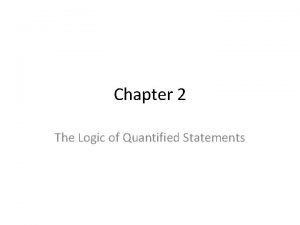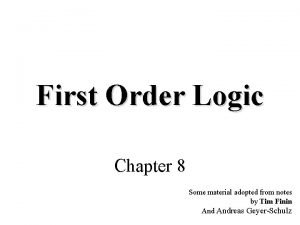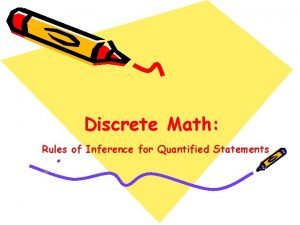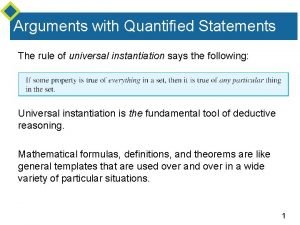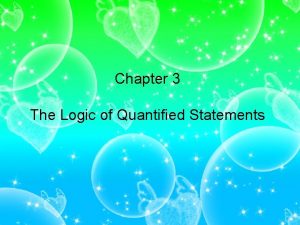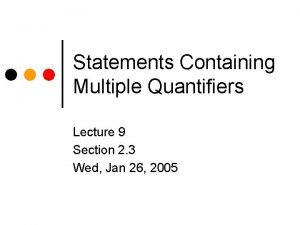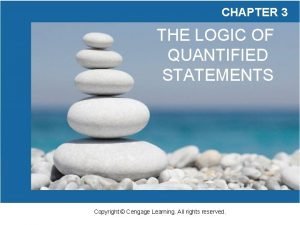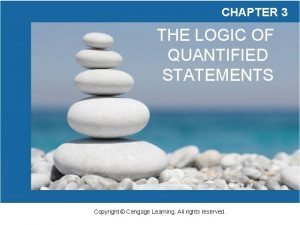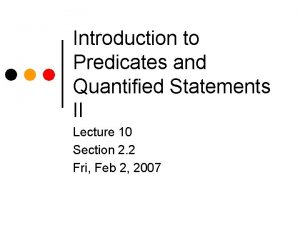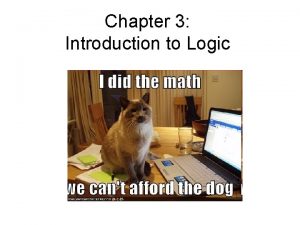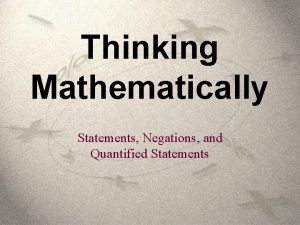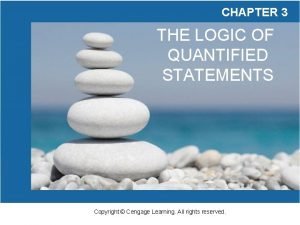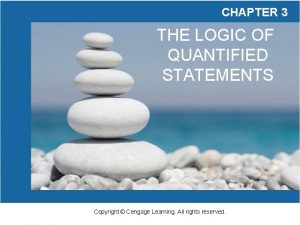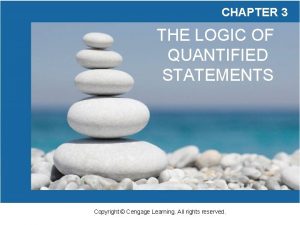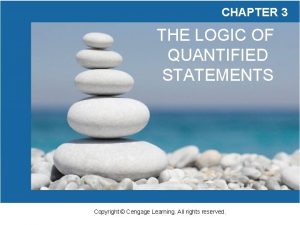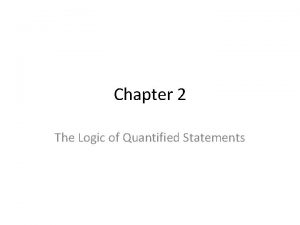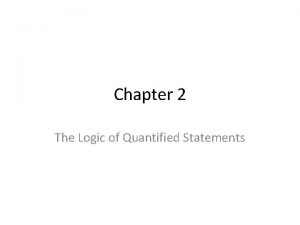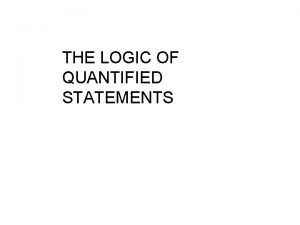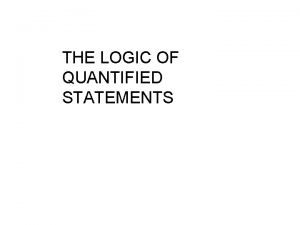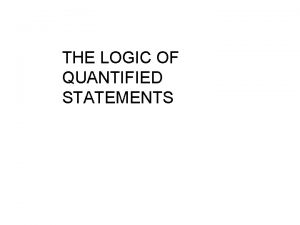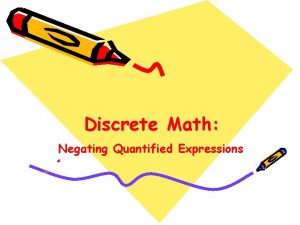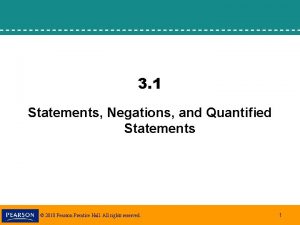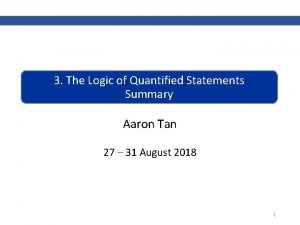CHAPTER 3 THE LOGIC OF QUANTIFIED STATEMENTS Copyright




















- Slides: 20

CHAPTER 3 THE LOGIC OF QUANTIFIED STATEMENTS Copyright © Cengage Learning. All rights reserved.

SECTION 3. 3 Statements with Multiple Quantifiers Copyright © Cengage Learning. All rights reserved.

Statements with Multiple Quantifiers When a statement contains more than one quantifier, we imagine the actions suggested by the quantifiers as being performed in the order in which the quantifiers occur. For instance, consider a statement of the form ∀x in set D, ∃y in set E such that x and y satisfy property P(x, y). 3

Statements with Multiple Quantifiers To show that such a statement is true, you must be able to meet the following challenge: • Imagine that someone is allowed to choose any element whatsoever from the set D, and imagine that the person gives you that element. Call it x. • The challenge for you is to find an element y in E so that the person’s x and your y, taken together, satisfy property P(x, y). 4

Example 1 – Truth of a ∀∃ Statement in a Tarski World Consider the Tarski world shown in Figure 3. 3. 1 Show that the following statement is true in this world: For all triangles x, there is a square y such that x and y have the same color. 5

Statements with Multiple Quantifiers Now consider a statement containing both ∀ and ∃, where the ∃ comes before the ∀: ∃ an x in D such that ∀y in E, x and y satisfy property P(x, y). To show that a statement of this form is true: You must find one single element (call it x) in D with the following property: • After you have found your x, someone is allowed to choose any element whatsoever from E. The person challenges you by giving you that element. Call it y. • Your job is to show that your x together with the person’s y satisfy property P(x, y). 6

Statements with Multiple Quantifiers Here is a summary of the convention for interpreting statements with two different quantifiers: Interpreting Statements with Two Different Quantifiers If you want to establish the truth of a statement of the form ∀x in D, ∃y in E such that P(x, y) your challenge is to allow someone else to pick whatever element x in D they wish and then you must find an element y in E that “works” for that particular x. 7

Statements with Multiple Quantifiers If you want to establish the truth of a statement of the form ∃x in D such that ∀y in E, P(x, y) your job is to find one particular x in D that will “work” no matter what y in E anyone might choose to challenge you with. 8

Example 3 – Interpreting Multiply-Quantified Statements A college cafeteria line has four stations: salads, main courses, desserts, and beverages. The salad station offers a choice of green salad or fruit salad; the main course station offers spaghetti or fish; the dessert station offers pie or cake; and the beverage station offers milk, soda, or coffee. Three students, Uta, Tim, and Yuen, go through the line and make the following choices: Uta: green salad, spaghetti, pie, milk Tim: fruit salad, fish, pie, cake, milk, coffee Yuen: spaghetti, fish, pie, soda 9

Example 3 – Interpreting Multiply-Quantified Statements cont’d These choices are illustrated in Figure 3. 3. 2 10

Example 3 – Interpreting Multiply-Quantified Statements cont’d Write each of following statements informally and find its truth value. a. ∃ an item I such that ∀ students S, S chose I. b. ∃ a student S such that ∀ items I, S chose I. c. ∃ a student S such that ∀ stations Z, ∃ an item I in Z such that S chose I. d. ∀ students S and ∀ stations Z, ∃ an item I in Z such that S chose I. 11

Translating from Informal to Formal Language 12

Translating from Informal to Formal Language Most problems are stated in informal language, but solving them often requires translating them into more formal terms. 13

Example 4 – Translating Multiply-Quantified Statements from Informal to Formal Language The reciprocal of a real number a is a real number b such that ab = 1. The following two statements are true. Rewrite them formally using quantifiers and variables: a. Every nonzero real number has a reciprocal. b. There is a real number with no reciprocal. The number 0 has no reciprocal. 14

Negations of Multiply-Quantified Statements 15

Negations of Multiply-Quantified Statements You can use the same rules to negate multiply-quantified statements that you used to negate simpler quantified statements. We have known that ∼(∀x in D, P(x)) ≡ ∃x in D such that ∼P(x). and ∼(∃x in D such that P(x)) ≡ ∀x in D, ∼P(x). 16

Negations of Multiply-Quantified Statements We apply these laws to find ∼(∀x in D, ∃y in E such that P(x, y)) by moving in stages from left to right along the sentence. First version of negation: ∃x in D such that ∼(∃y in E such that P(x, y)). Final version of negation: ∃x in D such that ∀y in E, ∼P(x, y). 17

Negations of Multiply-Quantified Statements Similarly, to find ∼(∃x in D such that ∀y in E, P(x, y)), we have First version of negation: ∀x in D, ∼(∀y in E, P(x, y)). Final version of negation: ∀x in D, ∃y in E such that ∼P(x, y). 18

Negations of Multiply-Quantified Statements These facts can be summarized as follows: 19

Example 8 – Negating Statements in a Tarski World Refer to the Tarski world of Figure 3. 3. 1. Write a negation for each of the following statements, and determine which is true, the given statement or its negation. a. For all squares x, there is a circle y such that x and y have the same color. Figure 3. 3. 1 b. There is a triangle x such that for all squares y, x is to the right of y. 20
 Quantified statement and negation examples
Quantified statement and negation examples First order logic uses quantified variables over objects
First order logic uses quantified variables over objects Rules of inference for quantified statements
Rules of inference for quantified statements Universal modus tollens example
Universal modus tollens example Quantified statement example
Quantified statement example Statements with multiple quantifiers
Statements with multiple quantifiers Multiply quantified statements
Multiply quantified statements Multiply quantified statements
Multiply quantified statements Negation of a quantified statement
Negation of a quantified statement The main goal of logic is to
The main goal of logic is to Principles of recipe development
Principles of recipe development What is a quantified statement
What is a quantified statement First order logic vs propositional logic
First order logic vs propositional logic First order logic vs propositional logic
First order logic vs propositional logic Third order logic
Third order logic Combinational logic circuit vs sequential
Combinational logic circuit vs sequential Cryptarithmetic problem logic+logic=prolog
Cryptarithmetic problem logic+logic=prolog Software project wbs example
Software project wbs example Majority circuit
Majority circuit Combinational logic sequential logic 차이
Combinational logic sequential logic 차이 Logic chapter 3
Logic chapter 3
